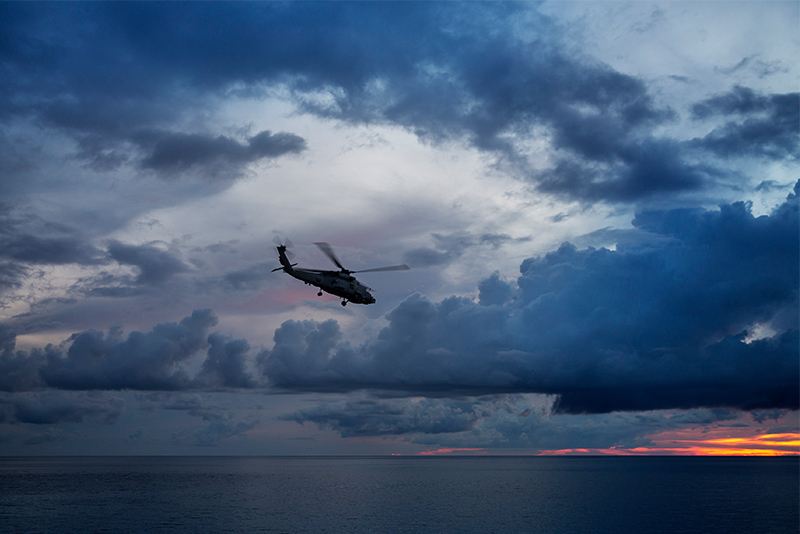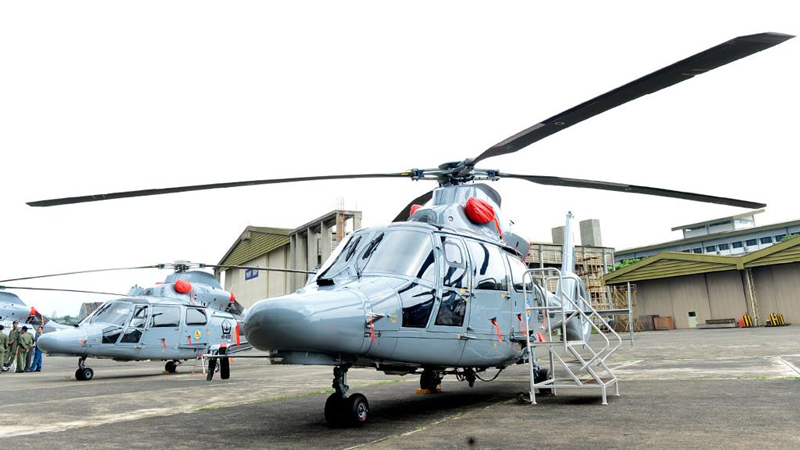The rise in the number of submarines being operated in Indo-Pacific waters has naturally led to a corresponding need for platforms, particularly maritime multi-mission rotorcraft, to deal with them.
“Since 2014, China has launched more submarines, warships, principal amphibious vessels and auxiliaries than the total number of ships currently serving in the navies of Germany, India, Spain, Taiwan and the United Kingdom,” stated Nick Childs, senior fellow for Naval Forces and Maritime Security, International Institute for Strategic Studies (IISS), on 1 May 2018 in a blog entitled: “China’s naval shipbuilding: delivering on its ambition in a big way.”
According to a briefing held at the Asia Society in Hong Kong by David Shear, the former US assistant defence secretary for Asian and Pacific security affairs on 21 March, 2019, the South China Morning Post reported that “an estimated 228 full-sized submarines [were] operating in the East and South China Seas – a number that is expected to rise to 300 within a decade.”
While many nations are ensuring that they have a “me too” submarine capability, Henry Boyd, a research fellow for Defence and Military Analysis, also at the IISS, suggested in an October 2017 blog that the People’s Liberation Army Navy (PLAN) will “focus on improving quality rather than expanding quantity” and would retain a total number of submarines around 58. This total was likely to comprise: four nuclear powered ballistic submarines (SSBNs); six attack submarines (SSN/SSGN); and around 48 diesel-electric powered submarines (SSK). However, more recent reports suggest that there is an ambition to have double the number of SSBNs to allow two to be at sea at any one time (working on the recognised principle that a total of four are required to ensure one is constantly deployed).
Republic of Korea Navy
There has been a reaction throughout the Indo-Pacific region to the increased focus on submarines activity with a corresponding need to find, fix and if necessary attack them.
The pursuit of additional anti-submarine warfare helicopters, known as the Maritime Operation Helicopter (MOH) batch-2 for the Republic of Korea Navy (ROKN) is still alive after the United States government made a late intervention on Lockheed Martin’s behalf. Leonardo, who had believed the competition to be a done deal after its rivals – Lockheed Martin/Sikorsky and NH Industries – did not submit proposals by a deadline leaving the way open for Leonardo.
The ROKN already operates eight Leonardo AW159 Wildcats following a decision by South Korea’s Defense Acquisition Program Administration (DAPA) in January 2013 to acquire the helicopters ahead of Sikorsky’s MH-60R Seahawk.
Lockheed Martin is trying to tie together both an Indian multi-role helicopter (MRH) requirement for 24 Sikorsky MH-60R helicopters, which has been approved by the US State Department under the Foreign Military Sales (PMS) procedure, with the ROKN opportunity. The Indian order is worth $2.6 billion with $840 million on offer for the 12 new ROKN helicopters.

Among the equipment that the US Defence Security Cooperation Agency (DSCA) has approved for sale to India in support of the MH-60R sale are the following: 30 Telephonics APS-153(V) multi-mode radars; 60 GE T700-GE-401C engines; 30 Raytheon AN/AAS-44C(V) multi-spectral targeting systems; 54 embedded global positioning system/inertial navigation systems (EGI) with selective availability/anti-spoofing modules (SAASM); 1,000 AN/SSQ-36/53/62 sonobuoys; and a broad selection of missiles, torpedoes, radios and 70 Harris AN/AVS-9 night vision goggles.
The size of the ROKN AW159s make them very capable of operating from the Incheon-class guided missile/coastal defence frigates are fitted with Leonardo’s Seaspray 7000E multi-mode active electronically scanned array (AESA) radar together with an electro-optical thermal sensor with a reported range of 190 nautical miles (360 kilometres). A decision is expected in the next few months according to sources close to the competition.
Philippines Navy
Leonardo has already been successful with another maritime customer, the Philippine Navy. The company has just completed the pre-delivery inspection of two AW159s at its Yeovil factory earlier in April, and will be delivering the aircraft to the Philippines Navy during May.
During the signing of the contract on 30 March, 2016, Defense Secretary Voltaire T. Gazmin underlined the importance of the acquisition, stating that it was “the country’s first anti-submarine warfare capability as the AFP moves towards attaining a minimum credible deterrence posture.” The helicopters are likely to be used not only maritime patrolling and deterrence, especially in the face of China, but also against insurgent groups operating within the Philippines themselves.
It is unlikely that the Philippine defence budgets will be able to afford any further additions to this small fleet.
Royal Malaysian Navy
Leonardo has also offered the AW159 to the Royal Malaysian Navy (RMN) which has a stated intent to further develop its existing Leonardo Super Lynx 300 helicopter which operate in the in the ASW and ASuW roles. A Leonardo spokesperson told AMR that the RMN is currently also considering various upgrade/modernisation options for its six Super Lynx 300 fleet which first came into service in 2003. In October 2018, the Super Lynx 300 flight logged a total of 10,000 hours
In May 2018, the UK Royal Navy’s 847 Naval Air Squadron, presented its AW159 Wildcat helicopter to Malaysia’s Armed Forces for detailed inspection and test flights at Royal Malaysian Navy Base Lumut and Leonardo Helicopters’ facility at Subang Airport, near Kuala Lumpur.
Indonesian Navy
Airbus Helicopters has had limited success in the Indo-Pacific region with its maritime AS565 MBe Panther. A total of 11 were procured by the Indonesian government for the Indonesian Navy – Tentara Nasional Indonesia-Angkatan Laut (TNI-AL) – with the first three being delivered in November of 2016. The contract is with Indonesian partner PT Dirgantara Indonesia (PTDI) who is responsible for the assembly and outfitting for role of the Panthers. By January 2019, PTDI had delivered 10 of the 11 helicopters.

The Panther’s ASW suite includes a dipping sonar and the ability to launch torpedoes. The Panther is powered by two Safran Arriel 2N engines giving it a top speed of around 165kts over a range of 780km.
Royal Australian Navy
An upgrade programme has already been approved by the DSCA under FMA to provide the Royal Australian Navy (RAN) with an upgrade programme for its Sikorsky MH-60R multi-mission helicopters at an estimated cost of $360 million. The Australian Government approved the acquisition of 24 MH-60R Seahawk in 2013 at a cost of over $3 billion to replace the older Sikorsky S-70Bs.
The upgrade programme would occur over 10 years.
The RAN has acquired the MH-60R Seahawk as its next generation submarine hunter and ASuW helicopter. It has a range of around 245nm with a maximum weight of 10,660kg (23,500lb) and a speed of up to 180kts.
Weapons include the Raytheon Mk54 Lightweight Torpedo, Lockheed Martin AGM-114N Hellfire laser-guided missiles and FN Herstal GAU-21 12.7mm crew served machine guns.
Sensors include Telephonics APS-153 multi-mode maritime surveillance radar which is operated through the Lockheed Martin Common Cockpit avionics suite, which allow the crew independent views of information available through the radar.
For its primary task of submarine hunting, there is a Raytheon AQS-22 Airborne Low Frequency
Sonar (ALFS) which is effective up to a depth of around over 750m (2,500 feet). The AN/AQS-22 dipping sonar has multi-frequency operation which allows it to adapt to varying environmental conditions. The helicopter can also launch up to 25 active, passive or bathymetric buoys.
Finally it also deploys with an AAS-44C multispectral infra-red targeting system which provides long-range surveillance, target acquisition, tracking, range finding and laser designation for the onboard weapons.
While at sea the MH-60Rs of 725 Squadron operate off the Anzac Class frigates and the new Air Warfare destroyers with the remainder staying at the home base of HMAS Albatross in Nowra, New South Wales. It is here at HMAS Albatross that all training is carried out through CAE USA, the prime contractor for MH-60R at Nowra. Within the suite of training devices to support the MH-60R are two Tactical Operational Flight Trainers (TOFTs) which comprise full-motion flight simulator and weapons tactics trainer for rear-crew sensor operators. According to CAE, the RAN MH-60R TOFTs were the world’s first MH-60R simulators certified to Level D, the highest qualification for flight simulators.
The NH Industries NH-90 NATO Frigate Helicopter (NFH) has not met with any great success in the Indo-Pacific region, losing out to the MH-60R and AW159s for maritime orders. The NH-90 Tactical Transport Helicopter (TTL) has been introduced as the MRH-90 into the Australian Army as a utility helicopter, which has also been qualified for naval resupply. Eight were also acquired by the Royal New Zealand Air Force (RNZAF) but deployment away from the mainland has proved difficult without an automated blade and tail flowing system which would make it suitable for longer term shipboard operations.
NH Industries has introduced a ‘hybrid’ helicopter called the NH-90 Maritime Tactical Transport which will feature elements from both of the initial variants, but will lend itself to maritime operations by incorporating folding main rotors and tail-boom, as well as a more resilient undercarriage.











